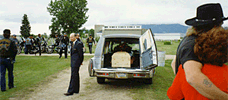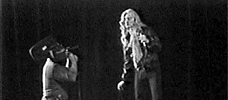Reviews
Peter Gilbert & Steve James
USA, 2008
Credits
Review by Victoria Large
Posted on 08 May 2008
Source 35mm print
Categories The 2008 Independent Film Festival of Boston
Of every screening at IFFB, Peter Gilbert and Steve James’ documentary At the Death House Door was the one that I waffled most about attending. The film chronicles the life and career of Reverend Caroll Pickett, who witnessed over ninety state-sanctioned executions during his tenure as chaplain at Texas’ Huntsville Prison. I was interested in the story, but I honestly wasn’t sure if I could take it. And as the end credits rolled - and someone behind me sarcastically thanked their friend for the uplifting Sunday afternoon at the movies - I was indeed devastated. But I wasn’t sorry that I came. At the Death House Door is harrowing viewing, but it feels like necessary viewing too.
For much of the runtime, this is a character study of Pickett, a man of many contradictions. He is introspective and displays compassion for the Huntsville prisoners - including obviously guilty men awaiting capital punishment - yet at the same time his presence at the executions makes him expressly complicit in them. (He even recounts one instance in which he himself gave the final command to administer a lethal injection.) Raised to support the death penalty (his own grandfather was a murder victim) and encouraged to suppress his emotions by a patriarch who insisted that his son never cry, Pickett appears to have molded himself into the strong silent type, at times jeopardizing his marriage and his family relationships with his stubborn reticence.
One thing that struck me about this film was how it questions the nature of strength and weakness, and indeed the equating of strength with silence. It is the breaking of silence that gives Pickett dimension for us, and from which much of this documentary’s power springs. We learn that the prison chaplain did find an outlet for the thoughts and emotions that overflowed with every death he had to witness on the job: Pickett spoke into a tape recorder after every execution, and those often eloquent and uniformly chilling recollections are excerpted here.
Gilbert and James’ use of these tapes is well-measured: brutally honest without veering into the sensational. They also find a use for silence, such as when a man who worked alongside Pickett on death row thinks back on his experiences and grows speechless, his pained expression carrying much the same weight as Pickett’s clear-eyed and detailed recollections. It’s essential that the filmmakers are not working in hypotheticals, where arguments over capital punishment are so often rooted. Pickett and others interviewed here have seen repentant and unrepentant criminals die; they have witnessed executions gone wrong, where supposedly quick and painless deaths became slow and agonizing torture. And Pickett is certain that he has seen an innocent man killed by the state.
It is this conviction that gives the documentary its second major narrative strand, the story of Carlos De Luna, a twenty-seven-year-old who was executed in 1989 for what many believe to be another man’s crime. Here the filmmakers introduce Chicago Tribune investigative reporters Steve Mills and Maury Possley, who are seeking answers about De Luna and compiling convincing evidence that his death was the result of a miscarriage of justice. The shift from Pickett’s reflections to Mills’ and Possley’s journalistic detective work jars at first, but the two stories eventually merge into one: Pickett was witness to De Luna’s death, and he begins working with De Luna’s sister, Rose Rohto, campaigning against the death penalty as well as leading the call to clear De Luna’s name. The time given to developing Pickett’s story and De Luna’s gives their intersection considerable heft, and the film coheres into a difficult, infuriating, worthwhile whole.
There’s a small moment late in the film when Rohto confesses to Pickett that she’s angry about what happened to her brother. Pickett urges her to “stay that way,” and that may be Gilbert and James’ hope for their audiences as well. Pickett, Rohto, and of many of the others interviewed - including reporter Karen Boudrie, who corresponded with De Luna while he awaited his sentence - frequently contemplate their own accountability for the death of De Luna and others. It may be this element of the film that sobers even the staunchest supporter of capital punishment. At the Death House Door is a shattering experience not simply because it deals with the brutality of crime and how it is answered with the brutality punishment, but because the film forces its audience to confront their own complicity in the process.
More The 2008 Independent Film Festival of Boston
-

Crawford
2008 -

Vexille
2007 -

American Teen
2008 -

Mister Lonely
2007 -

Intimidad
2008 -

Meadowlark
2008 -

Second Skin
2008 -

Transsiberian
2008 -

The Linguists
2008 -

Big Man Japan
2007 -

At the Death House Door
2008 -

The Beaver Trilogy
2000 -

The Beaver Trilogy
2000 -

Nerdcore Rising
2008 -

Goliath
2008 -

The Tracey Fragments
2007 -

Saviours
2008 -

Medicine for Melancholy
2008 -

Severed Ways
2007 -

Not Your Typical Bigfoot Movie
2008 -

Not Your Typical Bigfoot Movie
2008 -

Jump!
2007 -

Encounters at the End of the World
2007
We don’t do comments anymore, but you may contact us here or find us on Twitter or Facebook.



